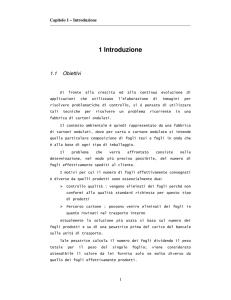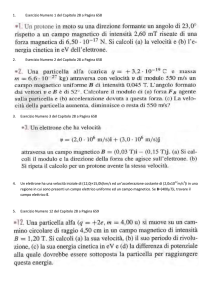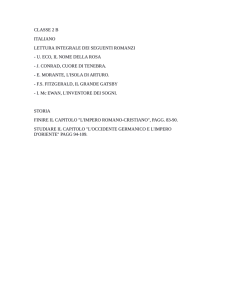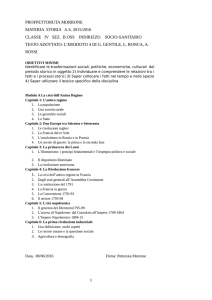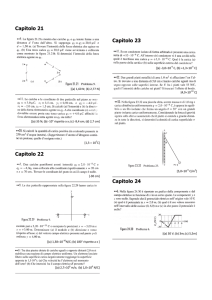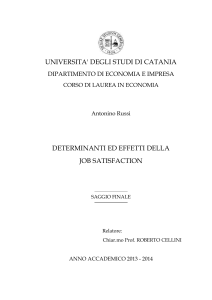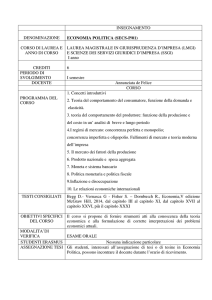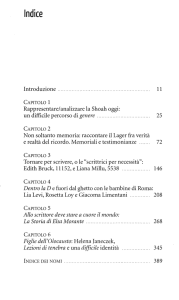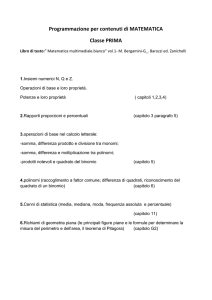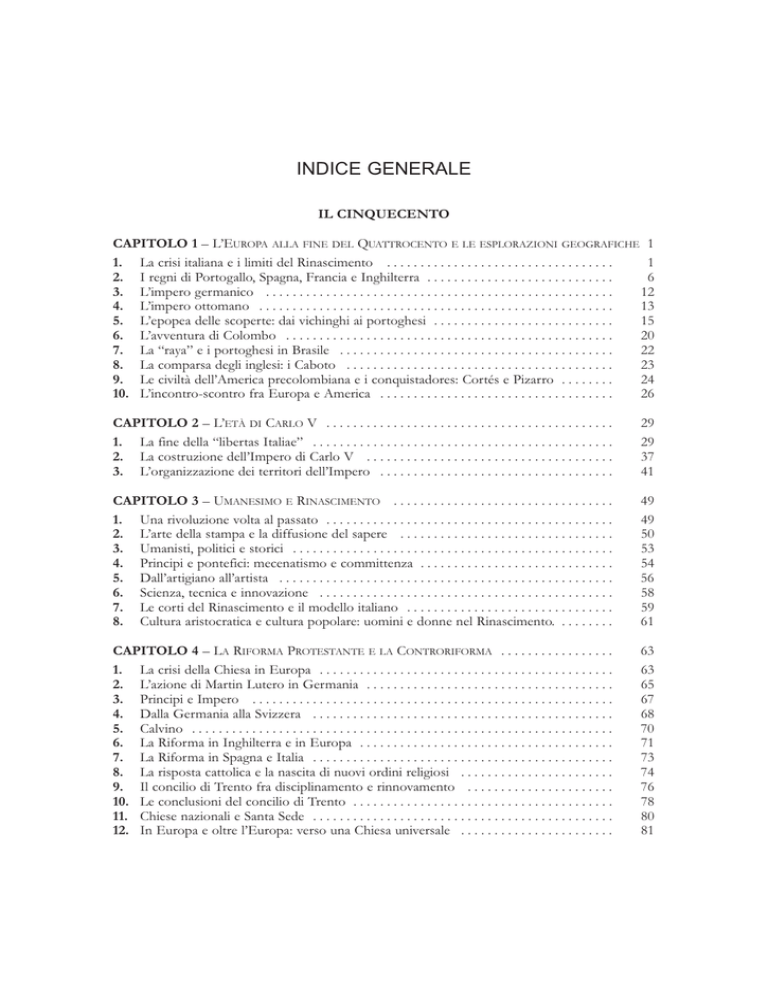
INDICE GENERALE
IL CINQUECENTO
CAPITOLO 1 – L’EUROPA ALLA FINE DEL QUATTROCENTO E LE ESPLORAZIONI GEOGRAFICHE 1
1. La crisi italiana e i limiti del Rinascimento . . . . . . . . . . . . . . . . . . . . . . . . . . . . . . . . . .
1
2. I regni di Portogallo, Spagna, Francia e Inghilterra . . . . . . . . . . . . . . . . . . . . . . . . . . . .
6
3. L’impero germanico . . . . . . . . . . . . . . . . . . . . . . . . . . . . . . . . . . . . . . . . . . . . . . . . . . . .
12
4. L’impero ottomano . . . . . . . . . . . . . . . . . . . . . . . . . . . . . . . . . . . . . . . . . . . . . . . . . . . . .
13
5. L’epopea delle scoperte: dai vichinghi ai portoghesi . . . . . . . . . . . . . . . . . . . . . . . . . . .
15
6. L’avventura di Colombo . . . . . . . . . . . . . . . . . . . . . . . . . . . . . . . . . . . . . . . . . . . . . . . . .
20
7. La “raya” e i portoghesi in Brasile . . . . . . . . . . . . . . . . . . . . . . . . . . . . . . . . . . . . . . . . .
22
8. La comparsa degli inglesi: i Caboto . . . . . . . . . . . . . . . . . . . . . . . . . . . . . . . . . . . . . . . .
23
9. Le civiltà dell’America precolombiana e i conquistadores: Cortés e Pizarro . . . . . . . .
24
10. L’incontro-scontro fra Europa e America . . . . . . . . . . . . . . . . . . . . . . . . . . . . . . . . . . .
26
CAPITOLO 2 – L’ETÀ DI CARLO V . . . . . . . . . . . . . . . . . . . . . . . . . . . . . . . . . . . . . . . . . . .
1. La fine della “libertas Italiae” . . . . . . . . . . . . . . . . . . . . . . . . . . . . . . . . . . . . . . . . . . . . .
2. La costruzione dell’Impero di Carlo V . . . . . . . . . . . . . . . . . . . . . . . . . . . . . . . . . . . . .
3. L’organizzazione dei territori dell’Impero . . . . . . . . . . . . . . . . . . . . . . . . . . . . . . . . . . .
29
29
37
41
CAPITOLO 3 – UMANESIMO E RINASCIMENTO . . . . . . . . . . . . . . . . . . . . . . . . . . . . . . . . .
1. Una rivoluzione volta al passato . . . . . . . . . . . . . . . . . . . . . . . . . . . . . . . . . . . . . . . . . . .
2. L’arte della stampa e la diffusione del sapere . . . . . . . . . . . . . . . . . . . . . . . . . . . . . . . .
3. Umanisti, politici e storici . . . . . . . . . . . . . . . . . . . . . . . . . . . . . . . . . . . . . . . . . . . . . . . .
4. Principi e pontefici: mecenatismo e committenza . . . . . . . . . . . . . . . . . . . . . . . . . . . . .
5. Dall’artigiano all’artista . . . . . . . . . . . . . . . . . . . . . . . . . . . . . . . . . . . . . . . . . . . . . . . . . .
6. Scienza, tecnica e innovazione . . . . . . . . . . . . . . . . . . . . . . . . . . . . . . . . . . . . . . . . . . . .
7. Le corti del Rinascimento e il modello italiano . . . . . . . . . . . . . . . . . . . . . . . . . . . . . . .
8. Cultura aristocratica e cultura popolare: uomini e donne nel Rinascimento. . . . . . . . .
49
49
50
53
54
56
58
59
61
CAPITOLO 4 – LA RIFORMA PROTESTANTE E LA CONTRORIFORMA . . . . . . . . . . . . . . . . .
1. La crisi della Chiesa in Europa . . . . . . . . . . . . . . . . . . . . . . . . . . . . . . . . . . . . . . . . . . . .
2. L’azione di Martin Lutero in Germania . . . . . . . . . . . . . . . . . . . . . . . . . . . . . . . . . . . . .
3. Principi e Impero . . . . . . . . . . . . . . . . . . . . . . . . . . . . . . . . . . . . . . . . . . . . . . . . . . . . . .
4. Dalla Germania alla Svizzera . . . . . . . . . . . . . . . . . . . . . . . . . . . . . . . . . . . . . . . . . . . . .
5. Calvino . . . . . . . . . . . . . . . . . . . . . . . . . . . . . . . . . . . . . . . . . . . . . . . . . . . . . . . . . . . . . . .
6. La Riforma in Inghilterra e in Europa . . . . . . . . . . . . . . . . . . . . . . . . . . . . . . . . . . . . . .
7. La Riforma in Spagna e Italia . . . . . . . . . . . . . . . . . . . . . . . . . . . . . . . . . . . . . . . . . . . . .
8. La risposta cattolica e la nascita di nuovi ordini religiosi . . . . . . . . . . . . . . . . . . . . . . .
9. Il concilio di Trento fra disciplinamento e rinnovamento . . . . . . . . . . . . . . . . . . . . . .
10. Le conclusioni del concilio di Trento . . . . . . . . . . . . . . . . . . . . . . . . . . . . . . . . . . . . . . .
11. Chiese nazionali e Santa Sede . . . . . . . . . . . . . . . . . . . . . . . . . . . . . . . . . . . . . . . . . . . . .
12. In Europa e oltre l’Europa: verso una Chiesa universale . . . . . . . . . . . . . . . . . . . . . . .
63
63
65
67
68
70
71
73
74
76
78
80
81
Il Mondo Moderno - Indice generale
CAPITOLO 5 – L’ETÀ DI FILIPPO II . . . . . . . . . . . . . . . . . . . . . . . . . . . . . . . . . . . . . . . . . .
1. La successione a Carlo V . . . . . . . . . . . . . . . . . . . . . . . . . . . . . . . . . . . . . . . . . . . . . . . .
2. Il sistema imperiale spagnolo . . . . . . . . . . . . . . . . . . . . . . . . . . . . . . . . . . . . . . . . . . . . .
3. Il conflitto con l’impero ottomano . . . . . . . . . . . . . . . . . . . . . . . . . . . . . . . . . . . . . . . .
4. Il problema delle minoranze etniche e religiose in Spagna . . . . . . . . . . . . . . . . . . . . . .
5. La successione portoghese . . . . . . . . . . . . . . . . . . . . . . . . . . . . . . . . . . . . . . . . . . . . . . .
6. I conflitti tra Spagna e Inghilterra . . . . . . . . . . . . . . . . . . . . . . . . . . . . . . . . . . . . . . . . .
7. Il declino della Spagna . . . . . . . . . . . . . . . . . . . . . . . . . . . . . . . . . . . . . . . . . . . . . . . . . .
85
85
88
91
94
96
97
99
CAPITOLO 6 – INGHILTERRA E PAESI BASSI . . . . . . . . . . . . . . . . . . . . . . . . . . . . . . . . . . .
1. L’Inghilterra di Enrico VIII . . . . . . . . . . . . . . . . . . . . . . . . . . . . . . . . . . . . . . . . . . . . . . .
2. Elisabetta I: sviluppo economico e consolidamento della potenza inglese . . . . . . . . .
3. Società e cultura: l’età di Shakespeare . . . . . . . . . . . . . . . . . . . . . . . . . . . . . . . . . . . . . . .
4. I Paesi Bassi: le origini di una nuova nazione . . . . . . . . . . . . . . . . . . . . . . . . . . . . . . . . .
5. La rivolta antispagnola e il distacco dalla Spagna . . . . . . . . . . . . . . . . . . . . . . . . . . . . . .
6. L’ascesa dell’Olanda . . . . . . . . . . . . . . . . . . . . . . . . . . . . . . . . . . . . . . . . . . . . . . . . . . . .
103
103
106
109
110
112
114
CAPITOLO 7 – AI CONFINI DELL’EUROPA: I PAESI BALTICI E LE REGIONI ORIENTALI . . .
1. I paesi baltici dalla crisi dell’Unione di Kalmar all’affermazione svedese . . . . . . . . . . .
2. Il regno di Polonia . . . . . . . . . . . . . . . . . . . . . . . . . . . . . . . . . . . . . . . . . . . . . . . . . . . . . .
3. La “Santa Russia” degli zar . . . . . . . . . . . . . . . . . . . . . . . . . . . . . . . . . . . . . . . . . . . . . . .
4. I turchi nei Balcani . . . . . . . . . . . . . . . . . . . . . . . . . . . . . . . . . . . . . . . . . . . . . . . . . . . . . .
117
117
119
121
123
CAPITOLO 8 – ECONOMIA E SOCIETÀ NEL CINQUECENTO . . . . . . . . . . . . . . . . . . . . . . . .
1. La demografia . . . . . . . . . . . . . . . . . . . . . . . . . . . . . . . . . . . . . . . . . . . . . . . . . . . . . . . . . .
2. Le attività agricole . . . . . . . . . . . . . . . . . . . . . . . . . . . . . . . . . . . . . . . . . . . . . . . . . . . . . .
3. Le attività industriali . . . . . . . . . . . . . . . . . . . . . . . . . . . . . . . . . . . . . . . . . . . . . . . . . . . . .
4. Le attività commerciali . . . . . . . . . . . . . . . . . . . . . . . . . . . . . . . . . . . . . . . . . . . . . . . . . .
127
127
130
133
137
IL SEICENTO
CAPITOLO 9 – IL SEICENTO: STATO ECONOMIA SOCIETÀ . . . . . . . . . . . . . . . . . . . . . . . . .
1. Il Seicento: una “crisi generale”? . . . . . . . . . . . . . . . . . . . . . . . . . . . . . . . . . . . . . . . . . . .
2. Il ristagno demografico . . . . . . . . . . . . . . . . . . . . . . . . . . . . . . . . . . . . . . . . . . . . . . . . . .
3. La congiuntura agraria . . . . . . . . . . . . . . . . . . . . . . . . . . . . . . . . . . . . . . . . . . . . . . . . . .
4. Il settore artigianale e produttivo . . . . . . . . . . . . . . . . . . . . . . . . . . . . . . . . . . . . . . . . . . .
5. Le reti degli scambi commerciali . . . . . . . . . . . . . . . . . . . . . . . . . . . . . . . . . . . . . . . . . . .
6. Finanza e credito . . . . . . . . . . . . . . . . . . . . . . . . . . . . . . . . . . . . . . . . . . . . . . . . . . . . . . .
7. Insurrezioni e rivolte . . . . . . . . . . . . . . . . . . . . . . . . . . . . . . . . . . . . . . . . . . . . . . . . . . . .
145
145
148
151
153
155
158
161
CAPITOLO 10 – SCIENZA E CULTURA . . . . . . . . . . . . . . . . . . . . . . . . . . . . . . . . . . . . . . . . .
1. Galilei e Keplero . . . . . . . . . . . . . . . . . . . . . . . . . . . . . . . . . . . . . . . . . . . . . . . . . . . . . . . .
2. La rivoluzione scientifica: astronomia, fisica, chimica . . . . . . . . . . . . . . . . . . . . . . . . . .
3. Gli strumenti e il metodo sperimentale . . . . . . . . . . . . . . . . . . . . . . . . . . . . . . . . . . . . .
4. Accademie, riviste, scuole e università . . . . . . . . . . . . . . . . . . . . . . . . . . . . . . . . . . . . . .
5. Scienza, religione e politica . . . . . . . . . . . . . . . . . . . . . . . . . . . . . . . . . . . . . . . . . . . . . . .
6. Arte, musica e teatro . . . . . . . . . . . . . . . . . . . . . . . . . . . . . . . . . . . . . . . . . . . . . . . . . . . .
7. Un’egemonia europea? . . . . . . . . . . . . . . . . . . . . . . . . . . . . . . . . . . . . . . . . . . . . . . . . . . .
167
167
168
171
172
175
176
178
IV
Indice generale
CAPITOLO 11 – L’ITALIA NEL XVII SECOLO . . . . . . . . . . . . . . . . . . . . . . . . . . . . . . . . . . .
1. Una nuova congiuntura economica . . . . . . . . . . . . . . . . . . . . . . . . . . . . . . . . . . . . . . . . .
2. L’organizzazione della società . . . . . . . . . . . . . . . . . . . . . . . . . . . . . . . . . . . . . . . . . . . . .
3. L’Italia spagnola . . . . . . . . . . . . . . . . . . . . . . . . . . . . . . . . . . . . . . . . . . . . . . . . . . . . . . . .
4. Gli altri Stati italiani . . . . . . . . . . . . . . . . . . . . . . . . . . . . . . . . . . . . . . . . . . . . . . . . . . . . .
181
181
185
187
195
CAPITOLO 12 – VERSO UN NUOVO EQUILIBRIO EUROPEO:
LA FRANCIA DA ENRICO IV A LUIGI XIV . . . . . . . . . . . . . . . . . . . . . . . . . . . . . . . . . . .
1. La Francia e le guerre di religione . . . . . . . . . . . . . . . . . . . . . . . . . . . . . . . . . . . . . . . . . .
2. Enrico IV e Maria dei Medici . . . . . . . . . . . . . . . . . . . . . . . . . . . . . . . . . . . . . . . . . . . . .
3. Luigi XIII e l’ascesa di Richelieu . . . . . . . . . . . . . . . . . . . . . . . . . . . . . . . . . . . . . . . . . . .
4. La Francia del cardinale Mazzarino: la Fronda . . . . . . . . . . . . . . . . . . . . . . . . . . . . . . . .
5. La presa di potere di Luigi XIV . . . . . . . . . . . . . . . . . . . . . . . . . . . . . . . . . . . . . . . . . . .
6. L’assolutismo francese . . . . . . . . . . . . . . . . . . . . . . . . . . . . . . . . . . . . . . . . . . . . . . . . . . .
7. La politica economica . . . . . . . . . . . . . . . . . . . . . . . . . . . . . . . . . . . . . . . . . . . . . . . . . . .
8. La politica estera e i conflitti con Roma . . . . . . . . . . . . . . . . . . . . . . . . . . . . . . . . . . . . .
203
203
205
207
208
210
212
213
215
CAPITOLO 13 – L’EUROPA CENTRALE E LA GUERRA DEI TRENT’ANNI . . . . . . . . . . . . . .
1. L’impero asburgico e l’inizio della guerra dei Trent’anni . . . . . . . . . . . . . . . . . . . . . . . .
2. L’intervento della Svezia e della Francia . . . . . . . . . . . . . . . . . . . . . . . . . . . . . . . . . . . . .
3. Fine della guerra: le paci di Vestfalia e dei Pirenei . . . . . . . . . . . . . . . . . . . . . . . . . . . . .
4. I paesi baltici . . . . . . . . . . . . . . . . . . . . . . . . . . . . . . . . . . . . . . . . . . . . . . . . . . . . . . . . . . .
5. L’ascesa della Prussia degli Hohenzollern . . . . . . . . . . . . . . . . . . . . . . . . . . . . . . . . . . . .
217
217
219
221
223
225
CAPITOLO 14 – L’EUROPA ORIENTALE . . . . . . . . . . . . . . . . . . . . . . . . . . . . . . . . . . . . . . .
1. L’Impero ottomano: le guerre con la Persia, con Venezia, con gli Asburgo . . . . . . . .
2. L’assedio di Vienna e l’effimera riscossa veneziana . . . . . . . . . . . . . . . . . . . . . . . . . . . .
3. Il tramonto della Polonia . . . . . . . . . . . . . . . . . . . . . . . . . . . . . . . . . . . . . . . . . . . . . . . . .
4. Una nuova presenza: la Russia di Pietro il Grande . . . . . . . . . . . . . . . . . . . . . . . . . . . .
229
229
231
233
234
CAPITOLO 15 – LE RIVOLUZIONI INGLESI E L’ANOMALIA OLANDESE . . . . . . . . . . . . . . . .
1. Gli Stuart . . . . . . . . . . . . . . . . . . . . . . . . . . . . . . . . . . . . . . . . . . . . . . . . . . . . . . . . . . . . . .
2. La guerra civile, la rivoluzione, il regicidio . . . . . . . . . . . . . . . . . . . . . . . . . . . . . . . . . . .
3. L’Inghilterra di Cromwell . . . . . . . . . . . . . . . . . . . . . . . . . . . . . . . . . . . . . . . . . . . . . . . . .
4. La restaurazione degli Stuart e la “rivoluzione gloriosa” . . . . . . . . . . . . . . . . . . . . . . . .
5. L’anomalia olandese e il Regno Unito dagli Orange agli Hannover . . . . . . . . . . . . . . .
239
239
244
246
248
251
IL SETTECENTO
CAPITOLO 16 – LE GUERRE DINASTICHE . . . . . . . . . . . . . . . . . . . . . . . . . . . . . . . . . . . . . .
1. Natura e peculiarità dei conflitti settecenteschi . . . . . . . . . . . . . . . . . . . . . . . . . . . . . . .
2. La guerra di successione spagnola . . . . . . . . . . . . . . . . . . . . . . . . . . . . . . . . . . . . . . . . . .
3. Vincitori e vinti: la politica dell’equilibrio . . . . . . . . . . . . . . . . . . . . . . . . . . . . . . . . . . . .
4. La riscossa spagnola: da Alberoni alla guerra di successione polacca . . . . . . . . . . . . . .
5. La guerra di successione austriaca e l’assetto territoriale della Penisola dopo . . . . . . .
Aquisgrana . . . . . . . . . . . . . . . . . . . . . . . . . . . . . . . . . . . . . . . . . . . . . . . . . . . . . . . . . . . .
255
255
257
259
262
265
V
Il Mondo Moderno - Indice generale
CAPITOLO 17 – L’ILLUMINISMO . . . . . . . . . . . . . . . . . . . . . . . . . . . . . . . . . . . . . . . . . . . . .
1. La crisi della coscienza europea . . . . . . . . . . . . . . . . . . . . . . . . . . . . . . . . . . . . . . . . . . . .
2. L’Illuminismo: il primato della ragione . . . . . . . . . . . . . . . . . . . . . . . . . . . . . . . . . . . . . .
3. Cultura, scienza e politica in Francia . . . . . . . . . . . . . . . . . . . . . . . . . . . . . . . . . . . . . . . .
4. La pubblicazione de l’Encyclopédie . . . . . . . . . . . . . . . . . . . . . . . . . . . . . . . . . . . . . . . . . .
5. La Massoneria e la polemica contro i Gesuiti . . . . . . . . . . . . . . . . . . . . . . . . . . . . . . . . .
6. La cultura economica: da Quesnais a Smith . . . . . . . . . . . . . . . . . . . . . . . . . . . . . . . . . .
7. Il dibattito sulla riforma della giustizia e le mancate riforme in Francia . . . . . . . . . . . .
271
271
272
274
277
278
281
284
CAPITOLO 18 – L’ETÀ DELLE RIFORME . . . . . . . . . . . . . . . . . . . . . . . . . . . . . . . . . . . . . . .
1. Significato storico e cause . . . . . . . . . . . . . . . . . . . . . . . . . . . . . . . . . . . . . . . . . . . . . . . .
2. Il dispotismo illuminato . . . . . . . . . . . . . . . . . . . . . . . . . . . . . . . . . . . . . . . . . . . . . . . . . .
3. Riformismo asburgico e riformismo borbonico . . . . . . . . . . . . . . . . . . . . . . . . . . . . . .
4. Milano, Firenze, Napoli e Parma . . . . . . . . . . . . . . . . . . . . . . . . . . . . . . . . . . . . . . . . . .
5. La situazione nei “vecchi” Stati: Torino, Genova, Venezia e Roma . . . . . . . . . . . . . . .
6. L’assolutismo prussiano . . . . . . . . . . . . . . . . . . . . . . . . . . . . . . . . . . . . . . . . . . . . . . . . . .
7. La Russia di Caterina II . . . . . . . . . . . . . . . . . . . . . . . . . . . . . . . . . . . . . . . . . . . . . . . . . .
8. Illuminismo senza riforme: l’Inghilterra . . . . . . . . . . . . . . . . . . . . . . . . . . . . . . . . . . . . .
9. La periferia: Svezia, Polonia, Impero ottomano . . . . . . . . . . . . . . . . . . . . . . . . . . . . . . .
289
289
291
293
297
301
303
304
306
307
CAPITOLO 19 – QUESTIONI EUROPEE E CONFLITTI COLONIALI:
LA GUERRA DEI SETTE ANNI E QUELLA PER L’INDIPENDENZA AMERICANA . . . . . . . . . .
1. Le colonie francesi e inglesi in America e in India. L’Australia . . . . . . . . . . . . . . . . . . .
2. Il rovesciamento delle alleanze e la guerra dei Sette anni . . . . . . . . . . . . . . . . . . . . . . .
3. La rivolta dei coloni del Nord America . . . . . . . . . . . . . . . . . . . . . . . . . . . . . . . . . . . . .
4. L’intervento franco-spagnolo e la conclusione della guerra . . . . . . . . . . . . . . . . . . . . .
5. La nascita degli Stati Uniti d’America e il loro assetto politico . . . . . . . . . . . . . . . . . . .
311
311
314
317
320
322
CAPITOLO 20 – LA RIVOLUZIONE INDUSTRIALE . . . . . . . . . . . . . . . . . . . . . . . . . . . . . . . .
1. Verso il sistema di fabbrica . . . . . . . . . . . . . . . . . . . . . . . . . . . . . . . . . . . . . . . . . . . . . . .
2. Agricoltura, popolazione e commercio nell’Inghilterra del Settecento . . . . . . . . . . . . .
3. Le miniere e la siderurgia . . . . . . . . . . . . . . . . . . . . . . . . . . . . . . . . . . . . . . . . . . . . . . . . .
4. La magia del vapore . . . . . . . . . . . . . . . . . . . . . . . . . . . . . . . . . . . . . . . . . . . . . . . . . . . . .
5. Innovazione e tecnologia . . . . . . . . . . . . . . . . . . . . . . . . . . . . . . . . . . . . . . . . . . . . . . . . .
6. L’industria tessile e la nascita del sistema di fabbrica . . . . . . . . . . . . . . . . . . . . . . . . . . .
7. Urbanesimo e questione sociale . . . . . . . . . . . . . . . . . . . . . . . . . . . . . . . . . . . . . . . . . . .
325
325
326
327
329
331
332
335
CAPITOLO 21 – LA RIVOLUZIONE FRANCESE E L’EUROPA NAPOLEONICA . . . . . . . . . . . . .
1. Le riforme impossibili e il 1789 . . . . . . . . . . . . . . . . . . . . . . . . . . . . . . . . . . . . . . . . . . . .
2. La rivoluzione borghese . . . . . . . . . . . . . . . . . . . . . . . . . . . . . . . . . . . . . . . . . . . . . . . . . .
3. La Repubblica e la nazione in armi . . . . . . . . . . . . . . . . . . . . . . . . . . . . . . . . . . . . . . . . .
4. Il Terrore . . . . . . . . . . . . . . . . . . . . . . . . . . . . . . . . . . . . . . . . . . . . . . . . . . . . . . . . . . . . . .
5. La reazione borghese: il Direttorio . . . . . . . . . . . . . . . . . . . . . . . . . . . . . . . . . . . . . . . . .
6. Bonaparte in Italia. Le repubbliche giacobine . . . . . . . . . . . . . . . . . . . . . . . . . . . . . . . .
7. La spedizione in Egitto e il colpo di Stato . . . . . . . . . . . . . . . . . . . . . . . . . . . . . . . . . . .
8. Il consolato: stabilità politica e pace in Europa . . . . . . . . . . . . . . . . . . . . . . . . . . . . . . .
9. L’Impero e la ripresa delle guerre . . . . . . . . . . . . . . . . . . . . . . . . . . . . . . . . . . . . . . . . . .
10. L’Europa di Napoleone . . . . . . . . . . . . . . . . . . . . . . . . . . . . . . . . . . . . . . . . . . . . . . . . . .
11. L’Italia napoleonica . . . . . . . . . . . . . . . . . . . . . . . . . . . . . . . . . . . . . . . . . . . . . . . . . . . . .
337
337
338
340
342
343
345
347
349
351
353
355
VI
Indice generale
12. La rivolta spagnola e la campagna di Russia . . . . . . . . . . . . . . . . . . . . . . . . . . . . . . . . . .
13. Il crollo dell’Impero e Waterloo . . . . . . . . . . . . . . . . . . . . . . . . . . . . . . . . . . . . . . . . . .
357
359
IL PRIMO OTTOCENTO
CAPITOLO 22 – L’ETÀ DELLA RESTAURAZIONE: L’EUROPA E L’ITALIA TRA LIBERALISMO E
CONSERVAZIONE . . . . . . . . . . . . . . . . . . . . . . . . . . . . . . . . . . . . . . . . . . . . . . . . . . . . . . . .
1. Restaurazione: un termine superato . . . . . . . . . . . . . . . . . . . . . . . . . . . . . . . . . . . . . . . .
2. Il Congresso di Vienna e il nuovo assetto europeo . . . . . . . . . . . . . . . . . . . . . . . . . . . .
3. Austria, Prussia e Russia . . . . . . . . . . . . . . . . . . . . . . . . . . . . . . . . . . . . . . . . . . . . . . . . . .
4. La Gran Bretagna da tory a liberale . . . . . . . . . . . . . . . . . . . . . . . . . . . . . . . . . . . . . . . . .
5. I moti del 1820-21: società segrete, costituzione e libertà . . . . . . . . . . . . . . . . . . . . . . .
6. L’indipendenza dell’America Latina . . . . . . . . . . . . . . . . . . . . . . . . . . . . . . . . . . . . . . . .
7. La Francia dal 1814 al 1830 e l’indipendenza del Belgio e della Grecia . . . . . . . . . . . .
8. Gli inizi del Risorgimento: l’Italia dopo il congresso di Vienna . . . . . . . . . . . . . . . . . .
9. La diffusione delle idee e le società segrete . . . . . . . . . . . . . . . . . . . . . . . . . . . . . . . . . .
10. I moti costituzionali del 1820-21 . . . . . . . . . . . . . . . . . . . . . . . . . . . . . . . . . . . . . . . . . . .
11. Mazzini e i moti del 1831. Nuove correnti politiche . . . . . . . . . . . . . . . . . . . . . . . . . . .
12. Economia, società e progresso scientifico . . . . . . . . . . . . . . . . . . . . . . . . . . . . . . . . . . .
361
361
362
365
366
367
369
371
373
376
377
378
380
BIBLIOGRAFIA . . . . . . . . . . . . . . . . . . . . . . . . . . . . . . . . . . . . . . . . . . . . . . . . . . . . . . . . . . . . . .
385
DINASTIE E PAPATI . . . . . . . . . . . . . . . . . . . . . . . . . . . . . . . . . . . . . . . . . . . . . . . . . . . . .
395
VII

